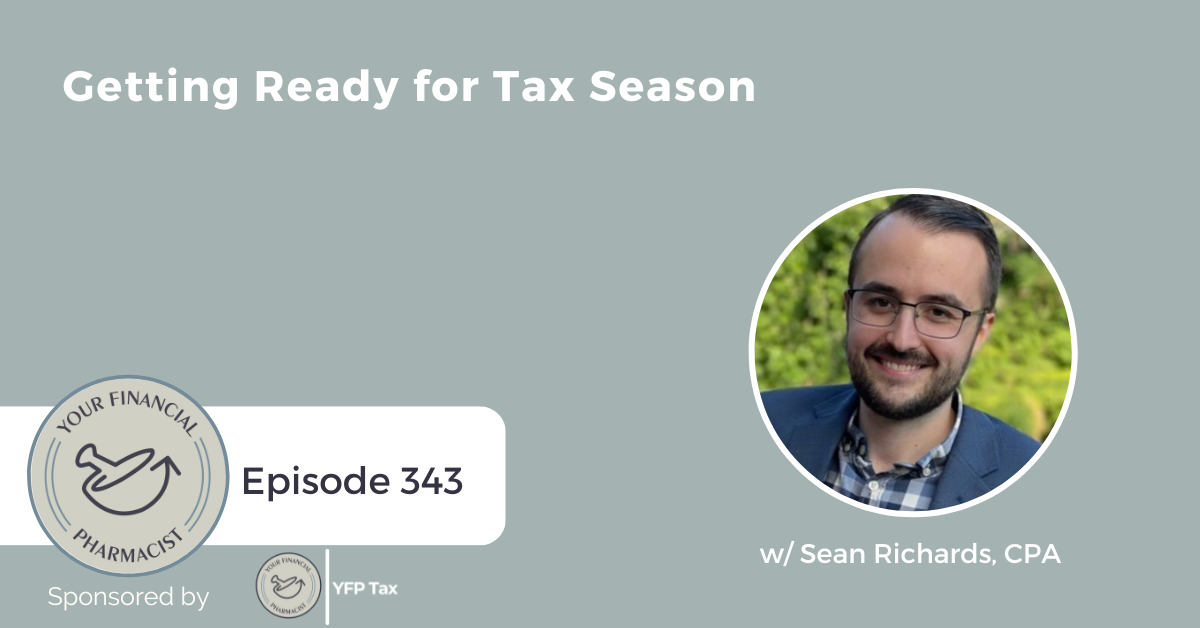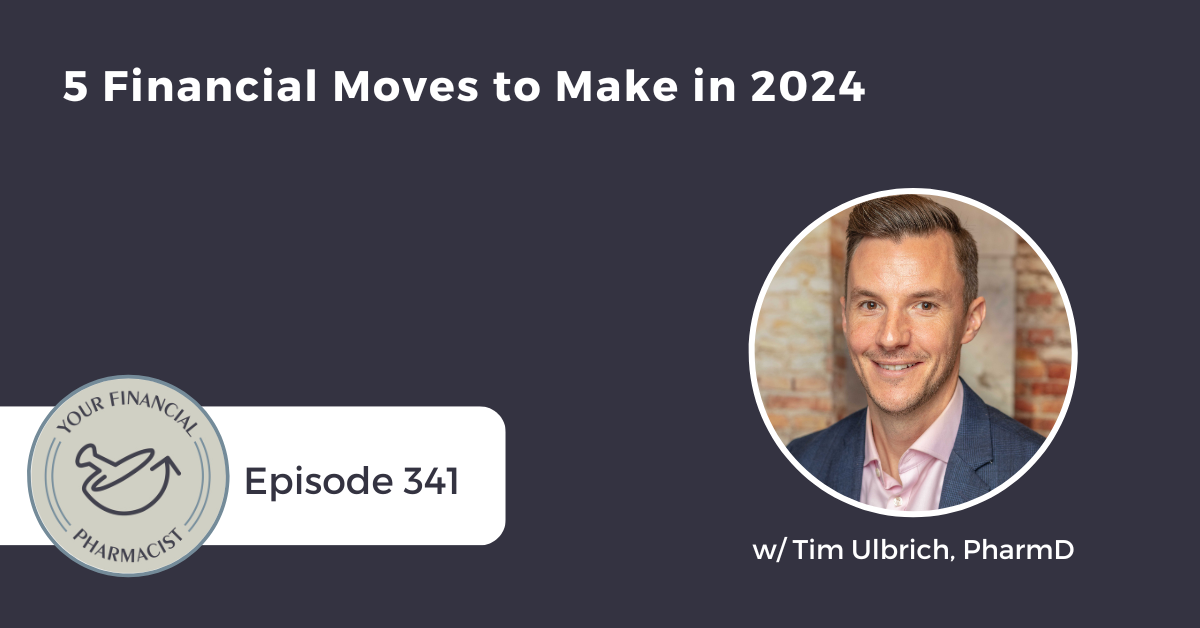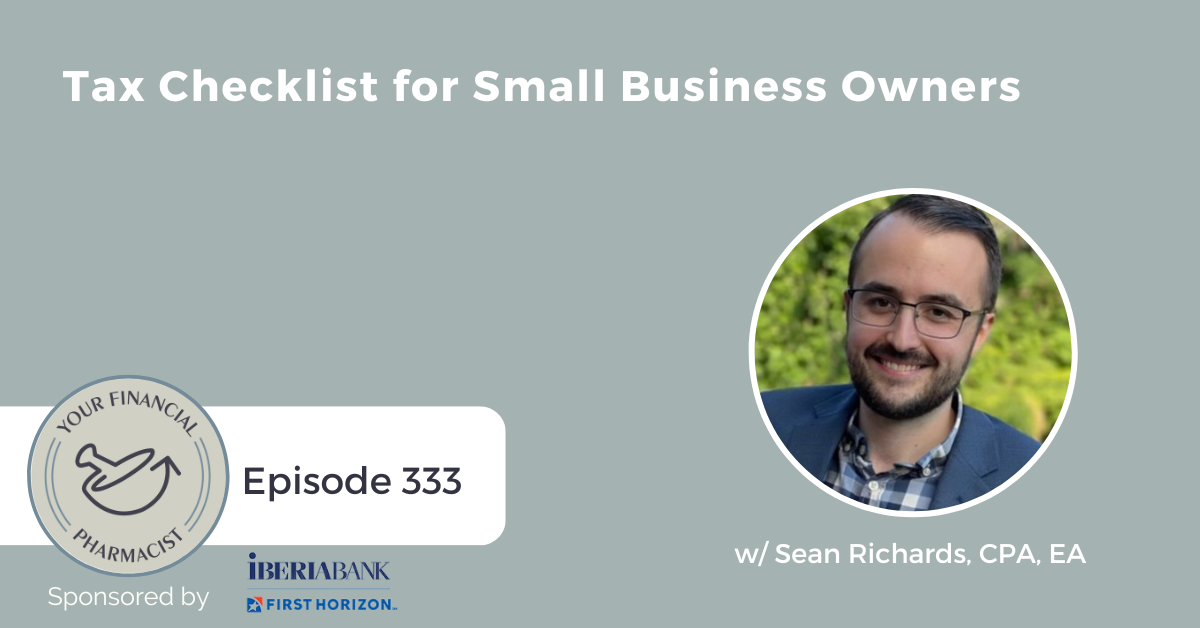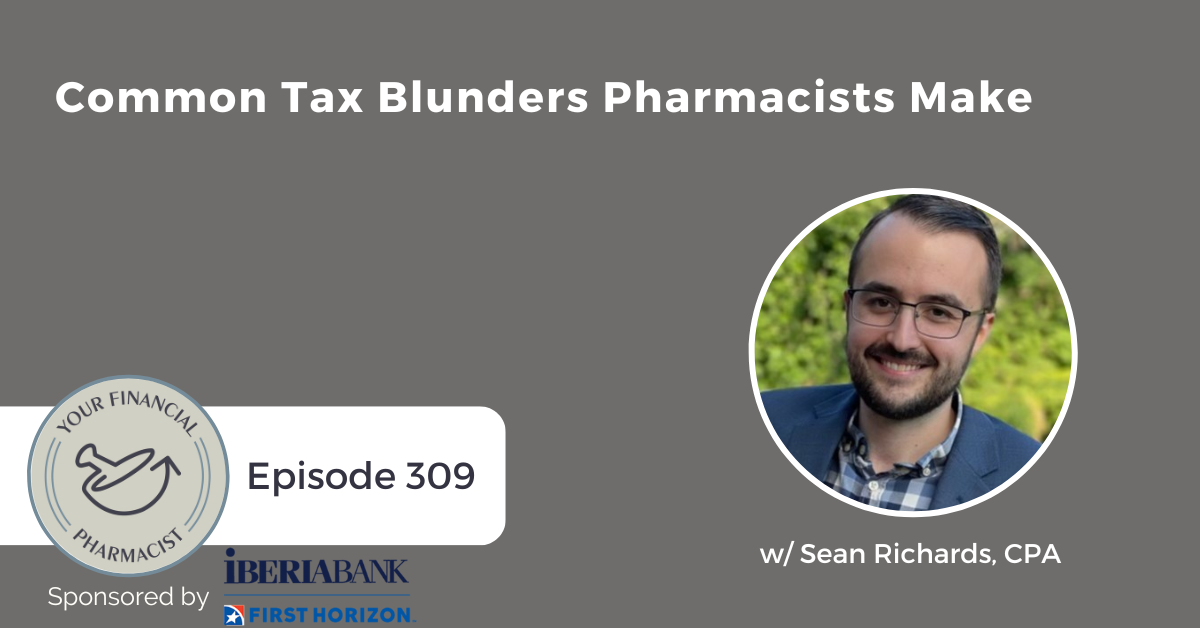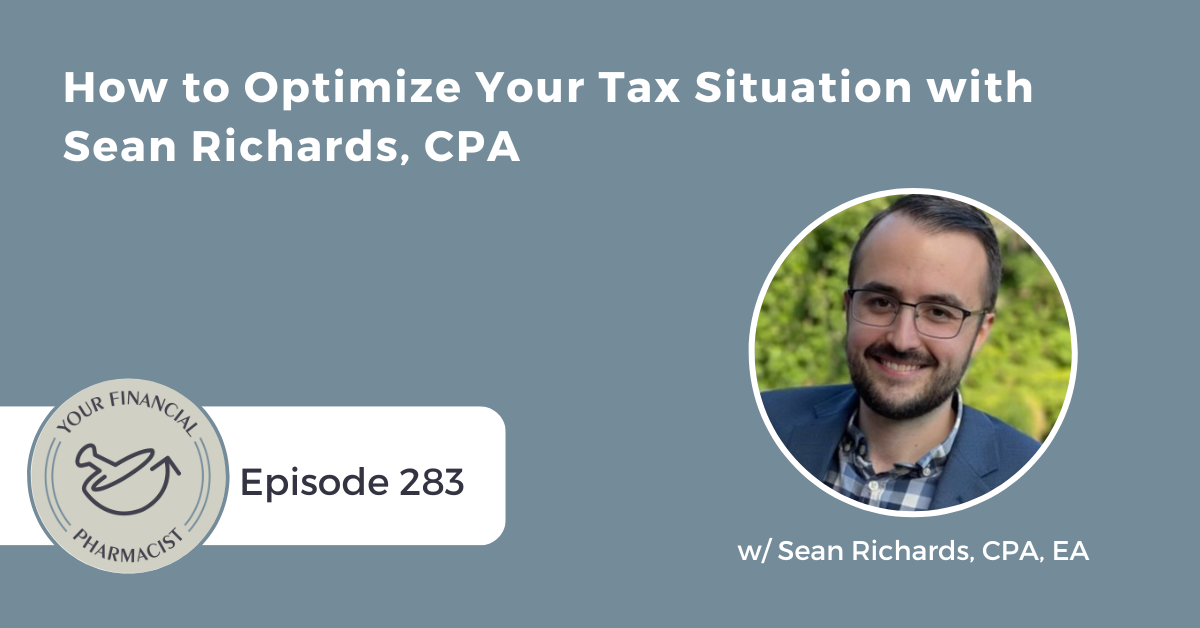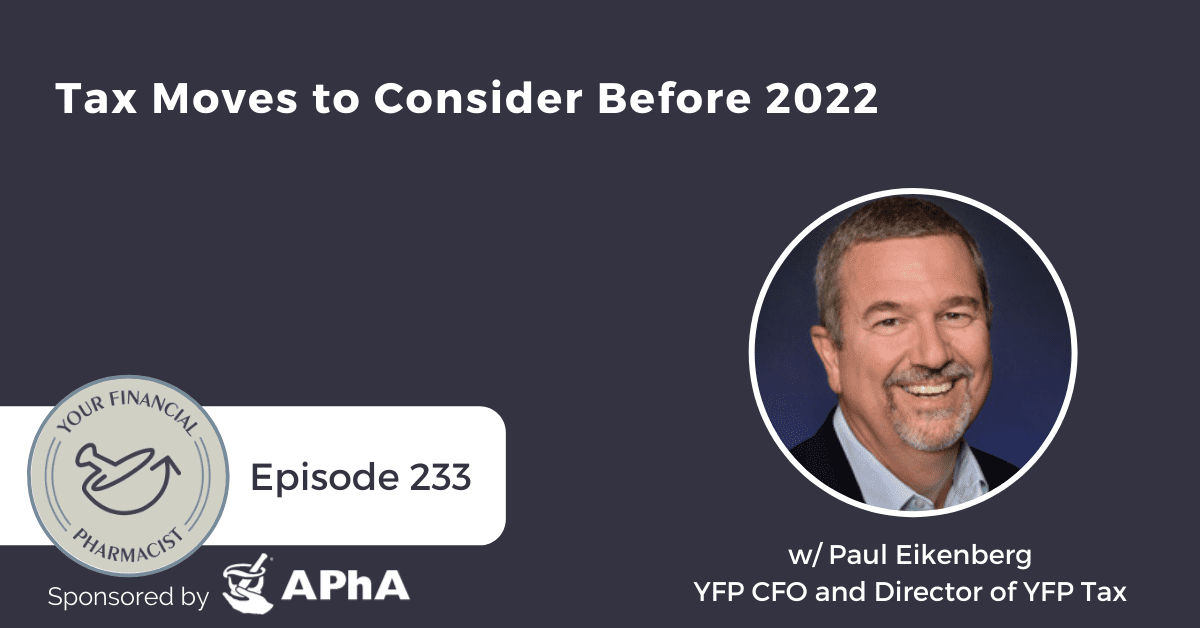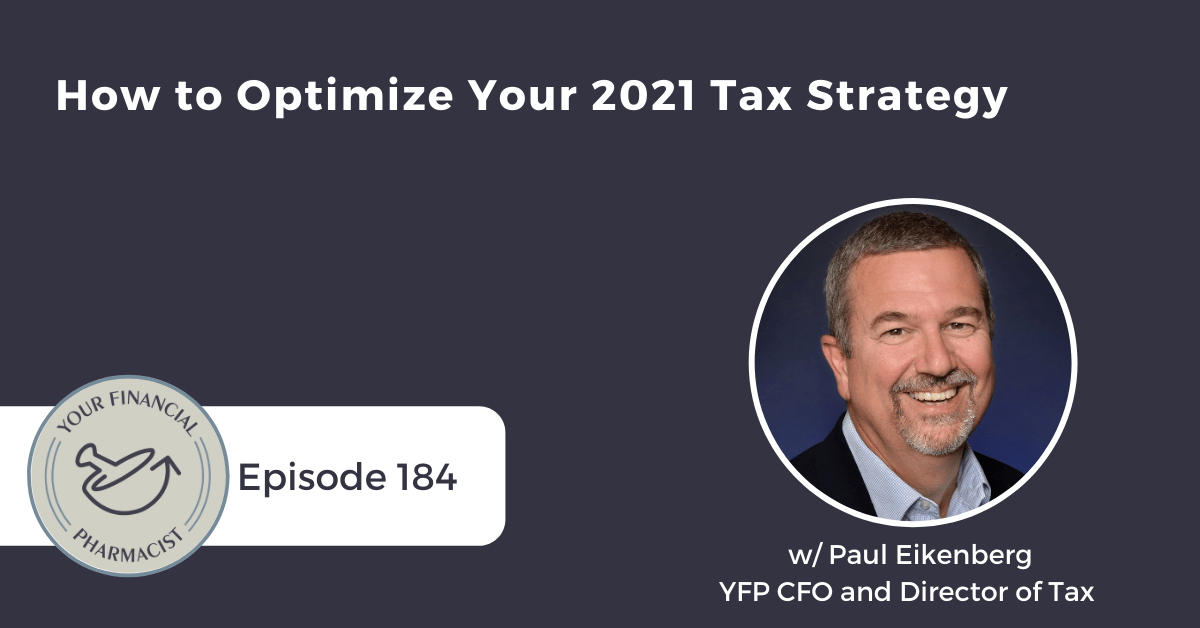Tim Ulbrich and Sean Richards, CPA, discuss the tax preparations listeners should be considering ahead of the 2023 filing.
Episode Summary
In this episode, Tim Ulbrich and Director of YFP Tax, Sean Richards, CPA, discuss the tax preparations listeners should be considering ahead of tax season and the 2023 filing. Whether you DIY your taxes or work with a professional, there are documents that need to be on hand to file your taxes. Sean shares essential tax moves for the year, emphasizing the significance of being proactive for the 2024 tax season. Sean also discusses the value of a year-round approach to taxes and the in-house services by episode sponsor, YFP Tax, showcasing the value of personalized, holistic tax planning.
About Today’s Guests
Sean Richards, CPA, received his undergraduate degree in Corporate Finance and Accounting, as well as his Master of Accountancy, from Bentley University in Waltham, MA. Sean has been a Certified Public Accountant (CPA) since 2015 and is currently pursuing his Enrolled Agent certification. Prior to joining the YFP team, Sean was the Senior Treasury Manager at PRA Group, a global debt buyer based in Norfolk, VA. He began his career at American Tower Corporation where, over 10 years, he held several positions in audit, treasury and accounting. As the Director of YFP Tax, Sean focuses on broadening the company’s existing tax planning and preparation operations, as well as developing and launching new accounting offerings, including bookkeeping, payroll, and fractional CFO services.
Key Points from the Episode
- Tax preparation for 2023 with a CPA. [0:00]
- Tax moves for 2023 and preparation for 2024. [1:11]
- Tax planning and preparation strategies for individuals and businesses. [8:56]
- Tax season preparation and changes. [13:59]
- Tax planning and goal setting for next year. [16:56]
- Comprehensive tax planning and year-round approach to taxes. [22:25]
- Year-round tax planning and personalized service. [27:24]
Episode Highlights
“And the big thing I’ll say about extensions is that the one of the things I’ve been noticing over the past few years is that there’s just this stigma about extensions, and how you know, a lot of people have never done it before. And it seems like it’s only something you can do if your situation is complicated. And it’s only something you can do if you are working with a professional and they need to do all the work for you and everything. But really extensions just give you and give your preparer more time to get things figured out, make sure that you are taking advantage of all your deductions and credits and everything.” – Sean Richards, CPA
“As Tim Baker would say, when it comes to extensions, right over rushed right over rush, right.” – Tim Ulbrich
“Yeah, I would be, you know, thinking about your own kind of general financial goals and then try to think about as you’re going through this whole tax filing process, how does your tax situation align with those goals?” – Sean Richards, CPA
“With comprehensive tax planning, is just looking at your taxes kind of throughout the course of the year like I’ve been alluding to throughout this whole conversation. And one big thing there is will be kind of what you were just saying that filing taxes. It’s not always really the finish line and might also be the starting point for somebody else.” – Sean Richards, CPA
“But with holistic plan, you have your tax return that you start with whatever is etched in stone sent to the government. And then from there, you’re able to sort of do whatever with testing out different types of scenarios and projections and looking at, hey, let’s take a look at our paychecks year to date, let’s see where are withholdings are at, let’s see what we expect our side income to be and our rental income. And oh, we’re going to have a kid this year congrats and, oh, we’re buying a house, let’s see how all these things play into our tax situation in the middle of the year.” – Sean Richards, CPA
“So there’s just so many different opportunities to, you know, maximize your efficiencies with your taxes, you know, take advantage of all the things that are out there. And if you don’t have a year round kind of approach to it, and you’re not looking at it in a cyclical kind of way, you’ll miss those things, you’ll come to filing, and you’ll be kicking yourself saying, let’s do it better this year, let’s do it better this year.” – Sean Richards, CPA
“So the name of the game with those is energies. Definitely still the big biggest thing. Energy efficiency, green initiatives. So people typically immediately think of EVs. I mean, that’s that’s a great example. And that’s one where the credits are sort of just getting better every year, there’s, more available to you” -Sean Richards, CPA
Links Mentioned in Today’s Episode
- YFP Tax
- Tax Checklist
- Your Financial Pharmacist
- Your Financial Pharmacist on Facebook
- Your Financial Pharmacist on Instagram
- Tim Ulbrich on LinkedIn
- Sean Richards on LinkedIn
- YFP Disclaimer
- YFP Newsletter
- Book a discovery call with Tim Baker
Episode Transcript
[INTRODUCTION]
Tim Ulbrich 00:00
Hey everybody, Tim Ulbrich here and thank you for listening to the YFP Podcast where each week we strive to inspire and encourage you on your path towards achieving financial freedom. This week YFP Director of Tax and CPA Sean Richards joins the show to discuss getting ready for the 2023 taxes. Yes, it’s that time of year tax season is officially upon us. And you probably started to receive various tax forms in the mail that are piling up if you haven’t already done so now is the perfect time to switch gears and start getting ready for the 2023 taxes. If you aren’t sure where to start, we’ve got you covered with a free checklist to help you along the way. In this free checklist we cover three final tax moves that you can make for the 2023 tax year, four ways to start prepping for tax season, and three key items that you can be doing now to plan ahead for this tax year and beyond. If you’re ready to take action and set the stage for a successful 2023 taxes, you can download this free checklist at yourfinancialpharmacist.com/taxchecklist. Again, that’s yourfinancialpharmacist.com/taxchecklist.
Tim Ulbrich 01:09
Sean, welcome back to the show.
Sean Richards 01:10
Thanks. Thanks for having me. And thanks for allowing me the chance to get on here before I disappeared. And hopefully I can spread some knowledge to folks again before I kind of go into my hole for the for the spring and start getting into the fun stuff that I live for.
Tim Ulbrich 01:26
Tis the season, hard to believe here we are and end of January thinking ahead to tax season. And we’re really excited about the work that you and the tax team are doing. We’ll get into that as we get towards the end of the episode. But we want to use this time of the year really as an opportunity to make sure that our community, our listeners are focused as early as they can on getting prepared for the tax season, whether they’re hiring a pro, like YFP tax, whether this is a DIY type of solution. You know, this is the season where we start to see those forms showing up in the mail, we put them aside on the desk. And then we want to do everything that we can to get ready. So we’re going to talk about in this episode, Sean, some some final tax moves that folks can make here. Even though we’re in 2024. We’re doing the 2023 filings. So some final moves that they can make. We’ll talk about getting ready for the tax season, how they can be prepared to make sure that the filing goes as smooth as possible. And then we’re to start the conversation about – as we’ve highlighted many times before on the show – we want to be as proactive as possible. So how can we be thinking ahead to the 2024 tax filing here in the beginning of the year, again with that proactive strategic approach. So before we jump into the meat of each of those sections of the podcast, Sean, just remind us of the deadlines. I think folks are probably familiar overall. But you know, we see more people in our community extending. So I think it’s worth talking about that as well. What are the deadlines that folks need to be thinking about this time of year as it relates to tax?
Sean Richards 03:01
Yeah, I mean, the big deadline that people typically are familiar with his tax day, and that’s usually April 15, which is this year, sometimes it falls on holidays, or, in fact, sometimes I’m from Massachusetts, and it often falls on a Massachusetts specific holiday. So we get a little bit of an extra push there that other states didn’t get but not not afforded to that anymore. But that mid-April date is typically the the regular sort of Tax Day date for regular individual filers, assuming that there’s no extension that’s filed. And the big thing I’ll say about extensions is that the one of the things I’ve been noticing over the past few years is that there’s just this stigma about extensions, and how you know, a lot of people have never done it before. And it seems like it’s only something you can do if your situation is complicated. And it’s only something you can do if you are working with a professional and they need to do all the work for you and everything. But really extensions just give you and give your preparer more time to get things figured out, make sure that you are taking advantage of all your deductions and credits and everything. And that bumps your regular tax deadline from April all the way to October. It’s six months. And it’s a guaranteed thing, basically. I mean, almost every state falls the Fed. And if you do the extension with the Fed, it’s guaranteed as long as you make a payment against any, you know, expected bills you’re gonna have. It’s just it’s worth doing. We do it for all of our clients proactively. That’s something we’ve been rolling out over the past couple years is just getting ahead of that, get it filed. And that way you don’t have to worry about it. You know, you can take your time figuring out if you think you’re going to owe any money, make an estimated payment, and then spend however much time you need to just dot all the i’s and cross the T’s and get everything figured out. You know, it’s what we see a lot of folks doing nowadays, it’s the way the industry is heading. So those are the two big individual deadlines. And if you’re a business owner and you actually have to file a business return, basically shift that up a month. Yeah. On March 15, and September, if you extend out.
Tim Ulbrich 05:03
As Tim Baker would say, when it comes to extensions, right over rushed. Right over rush, right. So I think when we look at tax season, you know, there’s a lot of work crammed in a short period of time, and we want to make sure that we’re doing it right. And that we’re, you know, optimizing the tax situation the best that we can. So let’s jump into the first section, first part of our discussion, which is some final 2023 tax moves that our listeners could make may or may not make sense, obviously, depending on their individual plan. So Sean, even though we’re in 2024, calendar year, there are some actions that can still be taken for the 2023 tax season. What are those key ones that our listeners should be thinking about?
Sean Richards 05:47
Yeah, and it’s one of those things that you always want to try to be doing things in the calendar year if you possibly can. But there are things that you aren’t going to be able to do by the end of the year. You know, some of these things with retirement contributions and stuff, you’re gonna want to know what your AGI is, or what you expect it to be. Or you might have to find out kind of what kind of cash flow you have available for yourself to make some of these different types of contributions and things. But right, so the IRS actually does allow some actions to be done after the tax season, when typically, if you’re a cash basis, taxpayer, it’s sort of whenever you get that cash, that’s the year that it happens. And so the big ones are retirement contributions, IRAs, specifically, those go out to your your regular deadline. So typically, it’s going to be April 15. For folks, the one I’ll mention there is that aside, for some exceptions, with some solo plans, 401K’s that’s typically a year end kind of thing. So if you didn’t max out on that, you probably don’t have much of an opportunity there. But again, you do have the opportunity to contribute to an IRA. So that’s something to look into. And I mentioned a solo 401K, but if you’re doing anything like that, or a sep IRA, those actually can be extended out if you have an extension. So another reason to file that extension, by yourself six more months to figure out where you’re gonna land, what kind of cash you have available to make a contribution towards something like that. And then the other big one is HSAs, very similar IRAs, it’s it goes to your your April deadline. So if you didn’t hit your max, or if your company contributed, but you still have some room to hit the max there, definitely tried to hit that that the HSA, I say it all the time, but it’s one of the few things that has the triple tax benefit of tax free contributions, tax free distributions, and tax free growth. So big one there. And then the other one is it. So it’s a little bit more, I don’t want to say complicated, but it’s, you know, not typically something that folks that are just having a regular kind of basic W2 job experience. But I was alluding to it before when I mentioned extensions, and that’s making estimated tax payments. So if you’re on a quarterly cadence where you know, your withholdings aren’t covering off on your tax bill, at the end of the year, whether you have side gigs, or it’s by design, you should be making estimated payments, those actually would have been due on the 15th of January. So hopefully, if anybody’s listening in, they’re supposed to make q4 payments and didn’t this will be a little reminder to go do that. But the other thing to keep in mind there is that even if you’re not making estimated payments, if you’re expected to have a balance due in April, you’ll want to make a payment against that before that date. So even if you do extend out, you know, get a rough number, do the math say hey, I think I’m going to owe approximately $1,000 make that payment now or any time between now and April. And then like I said, take the time, get your return figured out maybe that 1000 becomes 800. And you get to 200 of it back or, you know, you just buys you that time to really get things figured out. But you have the ability to make payments early anytime now for the 2023 season.
Tim Ulbrich 08:56
Yeah, and I think it’s really important. You know, for those that have been at this for a while they’re they’re probably well plugged into, hey, I can make IRA contributions after the first of the year, right before the deadline. I can make HSA contributions, but especially for, you know, our listeners that are relatively new at filing their own taxes or working with someone they may think which would be common sense that hey, calendar year is over. Therefore, opportunity’s gone. And as you’ve highlighted, that simply isn’t the case. And Sean, I also want to put a plug in when it comes to estimated tax payments -you mentioned this being a little bit more nuanced – and I think especially for those that have some more complicated tax situations, we’ll come back to this at the end. You can feel overwhelming in terms of you know, how do I determine that what’s the amount am I doing that correctly? What what changes are happening? And so I think this is a spot we’re really working with. Someone can be really valuable to feel comfortable and confident that you’re making those estimated tax payments. Yeah, in the correct way.
Sean Richards 09:50
We send out reminders to everybody that’s on that cadence and it might as well just be a reminder back to me because you know, all of our clients basically just say, I pay But we have the tools to go in and just you know, we have that number already figured out ahead of time. Usually it’s a little back and forth of hey, yeah, everything’s still the same, business still doing the same, you know, any changes on things, and we update our projections and get those numbers. But yeah, if you ever if you expect a big tax bill, or really have any kind of income, that you don’t have withholding for, that’s something you really should be thinking about. And if not working with a professional, at least having a plan to know what that number is going to be for yourself.
Tim Ulbrich 10:26
I get that email too from you, Sean. And then I say, hey, Sean, well, why don’t What is that supposed to be? So….
Sean Richards 10:31
I always push back a little bit to Hey, Tim, tell me about this.
Tim Ulbrich 10:34
Yeah, that’s right.
Sean Richards 10:35
He’s telling me to go check the books, so we go back and forth.
Tim Ulbrich 10:39
Awesome. So that’s the first part we want to talk about is making sure that we use this window of time right to make any of these 2023 tax moves before we file. The second part is getting ready preparing for the 2023 tax season. So Sean, we preach and teach proactive tax planning. And we’ll talk about that here shortly. Most of the focus this time of year is getting ready to file for the previous year. What are some things that our listeners can be doing should be doing to get organized, and be prepared for filing, whether they’re doing it themselves, or again, they’re hiring a tax professional.
Sean Richards 11:15
Yeah, whether you’re doing it yourself or hiring a tax professional, you’re gonna need to gather the documentation and either have it for yourself or give it to somebody. So that’s the big name of the game right now. So knowing when you’re going to get things, you know, a lot of that is you’re sort of at the mercy of whatever businesses you’re working with. So if it’s a bank, and you have interest income, there’ll be sending out 1099s. If you work for a company, and you get a paycheck, there’ll be sending W2s, the deadline for most of those is January 31. So folks are probably starting to get them in the mail now, if they have a little bit more proactive payroll companies. 1099, typically, they’re due on the 31st are most of them are and you’ll see those right around the 31st. Because those are a little harder to get out. But there’s other things that you can be gathering now to that may not actually have sort of deadlines that are going to be issued by a company, but things that you can pull together yourself. So if you have a rental property, you know, have you been taking income and expenses and have all that stuff figured out? Or if you work with a property management company? Do you know how you can go get that? Do you have a side business? Have you been tracking income and expenses there, you know, if you bought a house or sold a house this year, you’ll probably have the closing documentation and everything and that stuff that you’ll need or again, your accountant will need. So one good way to start is to just look at what you did last year and kind of figure hey, I needed all these things last year, I’ll probably need those again. And then think what did I had as a change this year? And you know, what could that possibly bring up? Having a system in place is great, you know, if you’re a client of ours, we have a tax questionnaire that I’m sure listeners are rolling their eyes saying, Oh, no, not again this year, though. I do promise it’s a lot prettier than it has been in the past. I’m really excited about some of the changes we’ve made there. But you know, it really guides folks through Hey, did you have this happen? Did you have this happen? Things that you might not think about. Hey, Oh, I did. I forgot I sold that stock in January of 2023. Right, of course. So just kind of understanding what situations you had in your tax life for the year, what forms may or may not be needed from that. And then when you’re going to be getting them and who you’re going to be getting them from. And sometimes it’s not even things that you’re going to be getting right now. Like I mentioned, if you have a business and your partner with that a business or an S corp or something, you might not get your K1 until September 15 when that extensions due. So there’s a lot of things for planning purposes, you know, if you know that you are a shareholder of a business, you’re going to want to file that extension now because there’s a good chance you’re not getting that until the summertime or something like that. So it’s a lot to think about. It might be overwhelming for folks. That’s why it’s you know, really good to have a system or work with a professional. But starting with last year is always a good place to start.
Tim Ulbrich 13:58
Yeah. And I found that to be really helpful. I use a combination of what you said. So I have a Google Drive, you know, folder for personal, for business, and I separate it by year. And then as those forms come in, you know, I’m scanning them, I’m dumping them into a folder just to kind of get them out of my mental space. And then exactly what he said, right, so I’m going through the tax questionnaire, which is super helpful to not only, you know, remind me of, okay, what were the forms last year that maybe I haven’t yet gotten or, you know, whatever, I need to look into that further. And then also asking those questions of are there new things that happen this year, and things that I need to be nudged and reminded of that might not have been represented in the documentation from the previous year? So I think a combination of the factors that you said, but that questionnaire I really like because that’s kind of the force point of are not only answering the questions, but then that’s the cue to upload all my tax forms and make sure that we have every documentation that’s needed, according to the questions that are being asked.
Sean Richards 14:59
Yeah, and like I said people are probably rolling their eyes. And I don’t mean that because the questionnaire itself is bad. It’s more that people are probably thinking, Oh, no, I have to gather those documents again. But unfortunately, everybody has to do that regardless. So you might as well have something that’s going to guide you through and remind you. It’s nice because like I said, our system is battle tested, we’ve had it for years now. You can put things in and save it and come back. So if you say, Ah, right, I forgot I had that transaction in January of 23. I mean, we’re already a year past that, when you’re filing, we might be a year and a half past. So it’s always good to have that little reminder to go back and get things.
Tim Ulbrich 15:36
As we’re talking about getting ready for the tax season. And the filing that’s coming up whether you know, that’s going to be the standard date or an extension. You know, the other thought I have here, Sean, is what new tax changes have been happening that folks, maybe or maybe not plugged into. And I feel like in years gone by, there’s been a lot more activity than than there was this past year. But talk us through some of the things that you’re seeing with our clients that our listeners might want to be tuned into.
Sean Richards 16:04
Yeah, I would say ’23 wasn’t the craziest year. I mean, it could just be with the election kind of coming up, maybe a lot of waves didn’t want to be made. But it also obviously comes down to Congress having to get things passed and making it through all of the checks and balances in the system. So we did have a lot of changes with the Inflation Reduction Act a couple of years ago that are kind of starting to roll out over the course of time. So I’d say that those were probably the biggest, year over year changes as far as actual real changes of like, Hey, this is a new creditor, this is a completely extended credit that used to, you know, phase out at $500. And now it’s 30%. with with no limits. So the name of the game with those is energies. Definitely still the big biggest thing. Energy efficiency, green initiatives. So people typically immediately think of EVs. I mean, that’s that’s a great example. And that’s one where the credits are sort of just getting better every year, there’s, more available to you. But even things that folks might not be thinking of. So if you had worked done on your house, there’s a pretty good chance that whatever you did was considered energy efficient by the powers that be and may qualify for at least some type of credit. So it’s worth at least thinking about, hey, I did this project, I replaced a window or I, you know, did some roof work or something like that, even just to ask the question of, Hey, can I get something for this? Worst case scenarios the answer is no. But you know, maybe next year or something. Aside from that, like I said, there weren’t a whole lot of crazy changes, there was a lot of increases across the board, just due to inflation with things like the standard deduction, and all of the kind of income brackets and everything. That’s not, you know, unusual, but it was a little bit more than it has been in the past, just given some of that inflation. And then there’s some new reporting requirements that know people are definitely getting fired up about. 1099k is a big one that gets thrown around a lot. So that’s with third party processors, if you work with like, Venmo, and things like that, and it scares people, because the question I get a lot is, hey, I, you know, send my dad 50 bucks every month for my cell phone bill, am I is he gonna get a 1099 at the end of the year for something like that? And the answer is probably not. The idea behind that is that third party payment providers, credit cards, Venmo, things like that are supposed to be identifying business transactions, because you know, you have that little button, you can click if you’re in Venmo, this is a business or purchase. And it gives you the insurance and everything, but it’s more intended for things like that. That’s not to say that you may get a 1099. Or it might come out of something like that, if you did give your family member $6,000 for something over the year. But that doesn’t also necessarily mean that it’s going to be income to that person. It’s just the company letting the government know, hey, this is the money that moved between these people. So a lot of things are getting thrown around. And you know, companies are trying to get people excited. So they’ll, you know, listen to their services and things like that. But I don’t want folks to be scared about these things. But definitely, you know, be inquisitive, ask your accountant, ask whoever you’re working with, hey, does this apply to me or you get something in the mail, ask them about it or you know, run it by somebody, don’t just say, Hey, I don’t think this applies to me. I’m not going to worry about it and deal with it later.
Tim Ulbrich 19:26
So thus far, Sean, everything we’ve talked about is really for the upcoming filing, again, whether that’s April or whether there’s an extension in October, so let’s shift gears to talk about thinking ahead to next year. So the 2024 tax filing. And again, even though we haven’t yet filed for 2023, we’re making decisions right now that are going to impact that filing. So we want to be thinking and planning as proactively as possible. And this is a great time of year to be doing it. So what are some of the areas, Sean, that folks should be thinking about here for next year’s filing in 2024.
Sean Richards 20:00
Yeah, I would be, you know, thinking about your own kind of general financial goals and then try to think about as you’re going through this whole tax filing process, how does your tax situation align with those goals? Or does it and if it doesn’t, should it and can we kind of shift it that way. So it could be something of, hey, I really want to pay off my student loans this year, that’s my my number one thing is that that’s what I want to do. So you might be more inclined to, you know, get more money in your paycheck in a particular year, in order to take that money and pay it against your debt, versus somebody who’s saying, hey, my number one goal by far is to lower my taxable income. And if that’s the case, you know, you don’t care about having your student loans paid off, or maybe you don’t have student loans, you just want your taxable income as low as possible. So we’re gonna max out 401K, we’re gonna max out HSAs or kind of, you know, do any of those types of things. So this is the time to really figure that out. Set goals for your tax situation that apply to your financial situation and overall strategy and also kind of come out of your tax return. Did you do your tax return and say, Oh, crap, I have a huge bill this year, I don’t, I don’t want that to happen. Or vice versa, oh, my goodness, I am getting a huge refund, I certainly could use that $1,000 a month back over the course of the year. This is the best time to identify those types of things and set those goals. And then from there, you can start to make changes, you can you know, if your goal is to not have a big tax bill at the end of the year, you can adjust your withholdings now and have 12 or 11 months of that to take effect. And by the end of the year, you’ll probably be in a good place. Or again, if you want to get more cash back to pay off your student loans, you can adjust your 401k or vice versa you want to lower your taxable income as much as absolutely possible, max out 401k. And now you have 11 months of that to go through. So it just a really good time to kind of get those goals set in place. Think about how you’re going to get there work with somebody who will build out a roadmap to get you there. And then just start checking in throughout the course of the year. It’s one of those things that once you file your taxes, I know everybody wants to say that they’re done. And it certainly is something you should celebrate. But it doesn’t mean that you should put it aside and not think of it till next year. Get those goals figured out now. And then, you know, constantly check in and make sure that you’re still on track.
Tim Ulbrich 22:25
Yeah, I like to think and we’ll talk about this with the services, we offer at YFP Tax. But I like to think about the filing is really the start line and not the finish line. Right. And, you know, as we talked about, in the very first section of this episode, there are some things that are calendar year deadlines, right? So we want to make sure that we’re taking advantage of those here in 2024. If it’s suitable for your plan, so that we’re not chasing it, you know, a year later, right, we’re able to really take advantage. And I think, as you mentioned, and highlighted well: it all starts with their goals. And this is why I’m so excited about the combination that we have of CFP and a CPA. When when you’re doing financial planning, and you’re doing that one on one and you have a CPA in your corner. That combination is really powerful as we can look across the financial planning and the strategy there, and then make sure we’re doing it in as tax efficient manner as possible. And just as a reminder, as I mentioned at the intro of the episode, we’ve got a checklist to kind of help guide you some of the things that we’ve been talking about, you can get a copy of that free checklist at your financialpharmacist.com/taxchecklist. And we’ll link to that, again in the show notes. Sean, let’s shift gears as we wrap up and talk about what we do at YFP Tax. Why we do it. By we I mean you! The philosophy, the philosophy, the philosophy behind this service and I think it’s it’s such a good thread to what we’ve been talking about. Yes, we’ve got work to do. We’ve got to file the IRS says we have to do but we also want to be thinking ahead and thinking proactively so we’re really excited. We’re now more than a year in of the shift we’ve made to offering comprehensive tax planning what we call CTP in-house. Tell our listeners, what is comprehensive tax planning and what does that offering look like at YFP Tax.
Sean Richards 24:16
Yeah, I’m excited too. It’s been you know about a year like you said of kind of having this as the flagship offering that we have on the tax side and it you know, I love where it where it’s been and where it is now and I love even more where we’re planning on taking it this year. But yeah, comprehensive tax planning, is just looking at your taxes kind of throughout the course of the year like I’ve been alluding to throughout this whole conversation. And one big thing there is will be kind of what you were just saying that filing taxes. It’s not always really the finish line and might also be the starting point for somebody else. It also is you know, could be the sort of middle of the year depending on what you have going on. Not everybody is on this exactly perfect cyclical cycle of hey Q1 of the year, which is this January, February, March, I’m going to be doing my full tax filings. And then mid year I’m going to be, you know, everybody, depending on what you have going on might be at different points in their individual tax cycle at any kind of point in the year. If you’re a business owner, you might not be filing your taxes until September, October. And then you know, you can’t be thinking about filing at this time of year when you’re going to be six months away from it. So comprehensive tax planning is really just having kind of a year round approach to your taxes and really catered to what you have going on. So again, where you’re at in the year, if it’s if it’s tax filing season, that’s what we’re focused on. If it’s more of that, you know, six months away from tax filing, we’re doing what we call tax projection. So we use a tool called holistic plan that we really use for our end to end tax process, which is amazing to have it all kind of in one place that we can carry over year after year. But with holistic plan, you have your tax return that you start with whatever is etched in stone sent to the government. And then from there, you’re able to sort of do whatever with testing out different types of scenarios and projections and looking at, hey, let’s take a look at our paychecks year to date, let’s see where are withholdings are at, let’s see what we expect our side income to be and our rental income. And oh, we’re going to have a kid this year congrats and, oh, we’re buying a house, let’s see how all these things play into our tax situation in the middle of the year. So we don’t come to whenever we file and say, Ooh, you know, I covered off on 75% of my stuff. But I kind of forgot about this whole other 25% here. So like I said, I love the projection process, I’m really excited to get into returns now and see exactly how accurate we were with them. And, you know, areas for improvement too. And not necessarily that we might have made mistakes or anything but looking at, hey, last year, we were really focused on the side income, but you know, you had more of an opportunity to be putting money toward your 401k and your W2 job that you had on the side there. So there’s just so many different opportunities to, you know, maximize your efficiencies with your taxes, you know, take advantage of all the things that are out there. And if you don’t have a year round kind of approach to it, and you’re not looking at it in a cyclical kind of way, you’ll miss those things, you’ll come to filing, and you’ll be kicking yourself saying, let’s do it better this year, let’s do it better this year.
Tim Ulbrich 27:24
I think he’s you articulated so well. We’ve really designed the service to match the philosophy we have right, which is tax is not one and done. It’s something we need to be thinking about throughout the year to really optimize this part of the financial plan the best that we can and I think the service does that incredibly well. And we do recognize Sean, that CTP comprehensive tax plan. We recognize that it’s not for everyone, right. So you know someone who is listening that, you know, is single, they’ve got one W two income, that withholdings are clean set correctly, there’s not a whole lot of changes, they probably aren’t in need at least yet. In terms of year round tax planning service. So with that in mind, who are you seeing with the clients that you’re working with YFP Tax that are getting the most value out of this year round service?
Sean Richards 28:11
I would say overall, you know, if you have a kind of a basic situation, that’s not typically the client that we’re seeing coming on and getting the most value out of it. That’s not to say that we don’t have plenty of people who want comprehensive tax planning, just to be able to say, hey, I don’t want to think about it. I just want someone’s hand on the wheel. And I want someone to take a look at my paycheck at the middle of the year and say, Hey, we’re still on track to have a $0 balance. And you know, we’re all good thumbs up and everything. There’s plenty of those. But I will say that the majority of folks are probably those who have slightly more of a complex tax situation or more of a complicated tax history or a little bit of both. So complicated tax history, think of things like big refunds or big bills, like I mentioned before, like, Oh, crap, you know, I’ve had a couple of years where I had big surprises that I wasn’t happy about, or I had that side gig and I completely forgot about that little thing called self employment tax, things like that. And then, you know, more complicated things. So real estate investors, tons of our clients have real estate, and there’s lots of opportunities to take advantage of tax laws there. And I don’t mean take advantage in in a shifty kind of way. There’s just so many different opportunities available to real estate investors out there. Folks with student loans, that’s obviously huge in the pharmacy space, stock purchase programs in restricted stock units. Another thing that’s huge in the pharmacy space, especially with our friends in the industry. So you know, those are definitely the biggest and then of course side hustlers and side gigs and stuff. But you know, I would definitely say that those are probably the biggest areas where we see people kind of proactively looking for that assistance. And like I said, just because your situation is uncomplicated doesn’t mean that you can’t benefit from having that year round look at it or if you anticipate it’s going to get more difficult getting ahead of that now, as opposed to, again, having that revisionist history and saying, Ooh, let’s hopefully not have that happen again, you know, to any extent you can get ahead of those things, it’s always a good thing in my mind.
Tim Ulbrich 30:14
Great stuff. And for those that want to learn more and determine, hey, is this a good fit for me, now is the time, right? So here in a little bit, we’re going to kind of shut down the doors and say, we’ve got to focus on really serving those clients well, so if you’re interested in learning more to determine, you know, for this year and beyond, can wifey tax add value to your tax situation, you can simply just go to YFPtax.com. From there, you’ll see an option to learn more and book a free discovery call that call will be with Tim Baker. And from there we can determine what the path is. That makes sense. And you know, Sean, just to be clear, you know, there are folks, as you mentioned, that might have some more straightforward situations, but want to know that someone has a hand on the wheel and want to know that they have someone in their corner year round, and that’s okay. But we aren’t and we’re not shy about it, we’re not trying to compete with big box solutions that are, you know, running commercials these days. 24/7 for, you know, free returns, right, very different apples and oranges, in terms of the level of service, the year round nature of it. And what we believe is, is really high touch as well. So again, learn more yfptax.com, you can book a discovery call, and we’d love to have the opportunity to discuss further. Sean, thanks so much. We’ll see you back in the spring perhaps when you’ve come out of hibernation well, not hibernation, because you’ll be working hard.
Sean Richards 31:30
It’s the opposite of hibernation. I’m not quite sure what the opposite exercise to that is. Yeah, yeah, hopefully I will emerge and not see my shadow or however that works. I will, I’ll see you in a couple months.
Tim Ulbrich 31:42
Awesome. And at that point, we’ll recap some of the things that you’ve probably been seeing throughout tax season and how people can be thinking again more proactively and strategically ahead. So thanks so much, and we’ll catch up later.
Sean Richards 31:53
Sounds good. Thanks, Tim.
Tim Ulbrich 31:56
As we conclude this week’s podcast and important reminder that the content on this show is provided to you for informational purposes only and is not intended to provide and should not be relied on for investment or any other advice. Information in the podcast and corresponding materials should not be construed as a solicitation or offer to buy or sell any investment or related financial products. We urge listeners to consult with a financial advisor with respect to any investment. Furthermore, the information contained in our archived newsletters, blog posts and podcasts is not updated and may not be accurate at the time you listen to it on podcasts, opinions and analyses expressed herein are solely those of Your Financial Pharmacist unless otherwise noted, and constitute judgments as of the date published. Such information may contain forward looking statements which are not intended to be guarantees of future events. Actual results could differ materially from those anticipated in the forward looking statements. For more information, please visit yourfinancialpharmacist.com/disclaimer. Thank you again for your support of the Your Financial Pharmacists Podcast. Have a great rest of your week.
[END]
Current Student Loan Refinance Offers
Note: Referral fees from affiliate links in this table are sent to the non-profit YFP Gives. | Bonus | Starting Rates | About | YFP Gives accepts advertising compensation from companies that appear on this site, which impacts the location and order in which brands (and/or their products) are presented, and also impacts the score that is assigned to it. Company lists on this page DO NOT imply endorsement. We do not feature all providers on the market. |
$800* Loans* ≥150K = $800 100-149K = $450 <100K = $350 | Variable: 5.28%+ APR (with autopay)* Fixed: 5.28%+ APR (with autopay)* *All bonus payments are by gift card. See terms | The "Kayak" of student loan refinancing, Credible displays personalized prequalified rates from multiple lenders | ||
$750* Loans ≥150K = $750* ≥50K-150k = $300 | Fixed: 5.49%+ APR (with autopay) | A marketplace that compares multiple lenders that are credit unions and local banks | ||
$500* Loans ≥50K = $500 | Variable: 4.99%+ (with autopay)* Fixed: 4.96%+ (with autopay)** Read rates and terms at SplashFinancial.com | Splash is a marketplace with loans available from an exclusive network of credit unions and banks as well as U-Fi, Laurenl Road, and PenFed |
Recent Posts
[pt_view id=”f651872qnv”]

